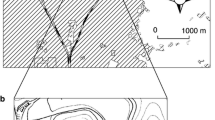Abstract
To clarify the effects of asynchronous seed production among tree species on the population of seed predators, we investigated the relationship between the annual variation in production of mature acorns and the insect damage in those acorns of two sympatric oak species, Quercus variabilis Blume and Quercus serrata Thunb. ex Murray, over 4 years at two study sites. The annual variation in acorn production was noticeable, with a coefficient of variation (CV) at the two sites of 1.05 and 0.80 for Q. variabilis and 0.87 and 0.73 for Q. serrata. Annual fluctuation in acorn production by Q. serrata was synchronized between the two sites. Since annual fluctuation in acorn production was not synchronized between the two species, the CVs for the total acorn production by both oak species (0.83 and 0.62 at the two sites) were lower than those for Q. variabilis and Q. serrata alone. The rate of predation by the specialist predators (Curculio weevils) on the acorns of both species was not related to the annual acorn crop size. Prolonged diapause of Curculio weevils might stabilize their populations. The rate of acorn predation by the generalist predators (tortricid moths) was also not related to the annual crop size. Asynchronous acorn production by the two oak species would help to stabilize the population.



Similar content being viewed by others
References
Crawley MJ, Long CR (1995) Alternate bearing, predator satiation and seedling recruitment in Quercus robur L. J Ecol 83:683–696
Espelta JM, Cortés P, Molowny-Horas R, Sánchez-Humanes B, Retana J (2008) Masting mediated by summer drought reduces acorn predation in Mediterranean oak forests. Ecology 89:805–817
Fujii S (1993) Studies on acorn production and seed predation in Quercus serrata—growth, falling phenology, estimation of production, and insect seed predators. Bull Osaka Mus Nat Hist 47:1–17
Fukumoto H, Kajimura H (1999) Seed-insect fauna of pre-dispersal acorns and acorn seasonal fall patterns of Quercus variabilis and Q. serrata in central Japan. Entomol Sci 2:197–203
Fukumoto H, Kajimura H (2001) Guild structures of seed insects in relation to acorn development in two oak species. Ecol Res 16:145–155
Fukumoto H, Kajimura H (2005) Cumulative effects of mortality factors on reproductive output in two co-occurring Quercus species: which mortality factors most strongly reduce reproductive potential? Can J Bot 83:1151–1158
Gray B (1972) Observations on Poecilips cardamomi (Schaufuss) the second species of Scolytidae to be found in bracken fern (Col.). Entomol Tidskr 93:229–237
Janzen DH (1971) Seed predation by animals. Annu Rev Ecol Syst 2:465–492
Kelly D (1994) The evolutionary ecology of mast seeding. Trends Ecol Evol 9:465–470
Kelly D, Koenig WD, Liebhold AM (2008) An intercontinental comparison of the dynamics behavior of mast seeding communities. Popul Ecol 50:329–342
Koenig WD, Mumme RL, Carmen WJ, Stanback MT (1994) Acorn production by oaks in central coastal California: variation within and among years. Ecology 75:99–109
Liebhold AM, Sork VL, Peltonen M, Koenig WD, Bjørnstad ON, Westfall R, Elkinton J, Knops JMH (2004) Within-population spatial synchrony in mast seeding of North American oaks. Oikos 104:156–164
Maeto K (1993) Acorn insects of Quercus mongolica var. grosseserrata in Hitsujigaoka natural forest, Hokkaido—life history of the principal species and their impacts on seed viability. Trans Annu Meet Hokkaido Br Jpn For Soc 41:88–90
Maeto K, Ozaki K (2003) Prolonged diapause of specialist seed-feeders makes predator satiation unstable in masting of Quercus crispula. Oecologia 137:392–398
Matsuda K (1982) Studies on the early phase of the regeneration of a konara oak (Quercus serrata Thunb.) secondary forest 1. Development and premature abscissions of konara oak acorns. Jpn J Ecol 32:293–302
Menu F (1993) Strategies of emergence in the chestnut weevil Curculio elephas (Coleoptera: Curculionidae). Oecologia 96:383–390
Menu F, Debouzie D (1993) Coin-flipping plasticity and prolonged diapause in insects: example of the chestnut weevil Curculio elephas (Coleoptera: Curculionidae). Oecologia 93:367–373
Menu F, Roebuck JP, Viala M (2000) Bet-hedging diapause strategies in stochastic environments. Am Nat 155:724–734
National Astronomical Observatory (2001) Chronological Scientific Tables. Maruzen, Tokyo
Nobuchi A (1981) Poecilips cardamomi (Schaufuss) (Coleoptera, Scolytidae) injurious to crown of strawberry and chestnut (Studies on Scolytidae XXIV). Jpn J Appl Entomol Zool 25:294–296
Pulido FJ, Díaz M (2005) Regeneration of Mediterranean oak: a whole-cycle approach. Ecoscience 12:92–102
Shibata M, Tanaka H, Iida S, Abe S, Masaki T, Niiyama K, Nakashizuka T (2002) Synchronized annual seed production by 16 principal tree species in a temperate deciduous forest, Japan. Ecology 83:1727–1742
Silvertown JW (1980) The evolutionary ecology of mast seeding in trees. Biol J Linn Soc 14:235–250
Sork VL, Bramble J, Sexton O (1993) Ecology of mast-fruiting in three species of North American deciduous oaks. Ecology 74:528–541
SPSS (2002) SPSS for Windows, release 11.5J [computer program]. SPSS, Chicago
Ueda A (1995) Field study of two spermathophagous scolytid beetles, Coccotrypes graniceps Eichhoff and C. cardamomi (Schaufuss), in acorns of Quercus myrsinaefolia Blume. In: Hain FP, Salom SM, Ravlin WF, Payne TL, Raffa KF (eds) Behavior, population dynamics and control of forest insects. The Ohio State University, Wooster, pp 610–626
Ueda A (2000) Pre- and post-dispersal damage to the acorns of two oak species (Quercus serrata Thunb. and Q. mongolica Fischer) in a species-rich deciduous forest. J For Res 5:169–174
Ueda A, Osumi K (2003) Insect attack on acorns of 4 deciduous oaks, Quercus serrata, Q. aliena, Q. acutissima, and Q. variabilis, at the same site. Appl For Sci 12:129–135
Acknowledgments
We thank the members of the Laboratory of Forest Protection, Nagoya University, for their helpful suggestions and for their assistance during the field surveys. This study was supported in part by a Grant-in-Aid for Scientific Research from JSPS (KAKENHI) (No. 20405025), and by funding from the Inamori Foundation in 2005, the IFO (Institute for Fermentation, Osaka) Foundation in 2007, and the Shouwahoukoukai (Ito Chube’e) Foundation in 2008.
Author information
Authors and Affiliations
Corresponding author
About this article
Cite this article
Fukumoto, H., Kajimura, H. Effects of asynchronous acorn production by co-occurring Quercus trees on resource utilization by acorn-feeding insects. J For Res 16, 62–67 (2011). https://doi.org/10.1007/s10310-010-0208-7
Received:
Accepted:
Published:
Issue Date:
DOI: https://doi.org/10.1007/s10310-010-0208-7




